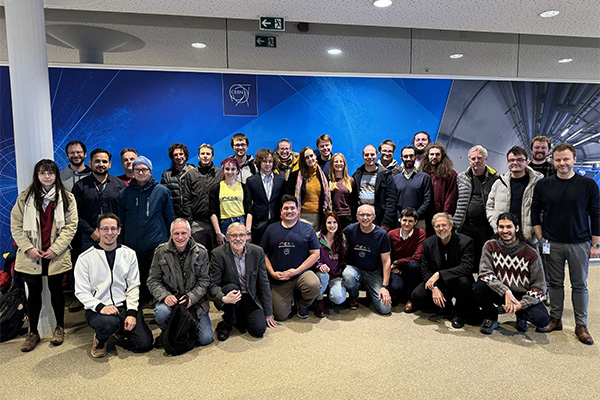AEgIS collaboration meeting takes place at CERN

The AEgIS collaboration convened at CERN in Geneva from 11 – 13 December 2023, for a comprehensive meeting to assess the accomplishments and advancements made in the past six months and to plan for the future of the experiment after the winter shutdown.
The meeting started with a welcome from AEgIS spokesperson Ruggero Caravita (Universita degli Studi di Trento and INFN) who also provided an overview of the agenda. The talks started with a presentation about the outreach initiatives undertaken by the collaboration. Subsequently detailed presentations on the main apparatus and the positron system were heard including discussion about performance and upgrades, and outlining plans for maintenance. An update on the current status of the Iodine source was provided, which will be integrated into the AEgIS experimental system. Insights into the performance, upgrades, and maintenance of the AEgIS antiproton trap system as well as the Data Acquisition (DAQ) and control system were also given. At the end of the first day, delegates heard updates on the performance and maintenance of the laser and of the injection/extraction line
The second day commenced with a presentation focusing on the efficient capturing and cooling of antiprotons from ELENA, along with the trap development for physics experiments. Following this, a talk about positronium excitation to Rydberg levels in a collinear geometry was given and then trap preparations for antihydrogen production were discussed. Talks on the formation of an antihydrogen beam, emphasizing ESDA analysis, MCP analysis, and detector development respectively as well as a presentation on the formation of highly charged ions followed. Finally presentations on simulations related to the capture process of antiprotons and antiproton counting were given.
At the end of the second day a collaboration board meeting took place to discuss future experimental plans. Tomasz Sowinski (Polish Academy of Sciences) was appointed as the coordinator for financing and bookkeeping for the AEgIS experiment, while Benjamin Rienacker (University of Liverpool) assumed a new role as the physics coordinator at AEgIS.
The final day of the collaboration meeting started with a presentation focusing on the visualization and dashboard for ALPACA after which micro-services for processes were discussed. A captivating talk on portable antiproton traps was heard after which anion spectroscopy was discussed. Later, talks were presented on the redesign of the new 1T region and the assembly of the new 1T MCP. Subsequently, the topic of external scintillators for antihydrogen annihilation timing was covered and then there was a talk on Doppler Shift Spectroscopy as a tool for non-invasive beam diagnostics. In the afternoon different design aspects of image plane detectors were discussed, followed by a presentation on 1s-3s and 1s-2s Ps spectroscopy in AEgIS. An intriguing talk on the physics of positronium and its charged ions from a theoretical perspective was delivered plans for the winter shutdown and upgrade schedule were presented which was followed by a discussion on the possibilities for Ps physics during the winter shutdown.
The AEgIS collaboration meeting proved to be a dynamic and insightful event. Over the course of three days, participants engaged in comprehensive discussions and presentations, showcasing the significant progress made in the past six months. From the efficient catching and cooling of antiprotons to the development of traps for physics experiments, and from positronium excitation to the formation of highly charged ions, the diverse range of topics addressed underscored the collaborative efforts and expertise within the AEgIS community.